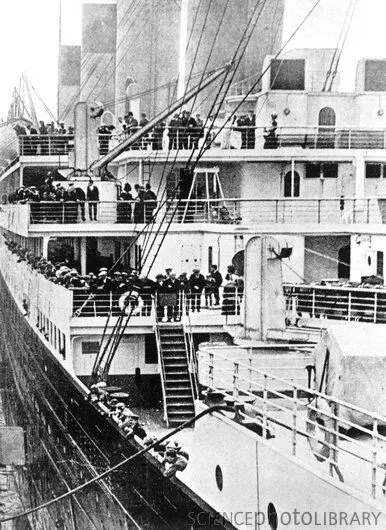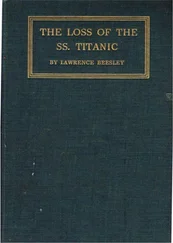It is related that on the night of the disaster, right up to the time of the Titanic’s sinking, while the band grouped outside the gymnasium doors played with such supreme courage in face of the water which rose foot by foot before their eyes, the instructor was on duty inside, with passengers on the bicycles and the rowing-machines, still assisting and encouraging to the last. Along with the bandsmen it is fitting that his name, which I do not think has yet been put on record—it is McCawley—should have a place in the honourable list of those who did their duty faithfully to the ship and the line they served.
CHAPTER II
From Southampton to the Night of the Collision
Soon after noon the whistles blew for friends to go ashore, the gangways were withdrawn, and the Titanic moved slowly down the dock, to the accompaniment of last messages and shouted farewells of those on the quay. There was no cheering or hooting of steamers’ whistles from the fleet of ships that lined the dock, as might seem probable on the occasion of the largest vessel in the world putting to sea on her maiden voyage; the whole scene was quiet and rather ordinary, with little of the picturesque and interesting ceremonial which imagination paints as usual in such circumstances. But if this was lacking, two unexpected dramatic incidents supplied a thrill of excitement and interest to the departure from dock. The first of these occurred just before the last gangway was withdrawn:—a knot of stokers ran along the quay, with their kit slung over their shoulders in bundles, and made for the gangway with the evident intention of joining the ship. But a petty officer guarding the shore end of the gangway firmly refused to allow them on board; they argued, gesticulated, apparently attempting to explain the reasons why they were late, but he remained obdurate and waved them back with a determined hand, the gangway was dragged back amid their protests, putting a summary ending to their determined efforts to join the Titanic. Those stokers must be thankful men to-day that some circumstance, whether their own lack of punctuality or some unforeseen delay over which they had no control, prevented their being in time to run up that last gangway! They will have told—and will no doubt tell for years—the story of how their lives were probably saved by being too late to join the Titanic.
The second incident occurred soon afterwards, and while it has no doubt been thoroughly described at the time by those on shore, perhaps a view of the occurrence from the deck of the Titanic will not be without interest. As the Titanic moved majestically down the dock, the crowd of friends keeping pace with us along the quay, we came together level with the steamer New York lying moored to the side of the dock along with the Oceanic, the crowd waving “good-byes” to those on board as well as they could for the intervening bulk of the two ships. But as the bows of our ship came about level with those of the New York, there came a series of reports like those of a revolver, and on the quay side of the New York snaky coils of thick rope flung themselves high in the air and fell backwards among the crowd, which retreated in alarm to escape the flying ropes. We hoped that no one was struck by the ropes, but a sailor next to me was certain he saw a woman carried away to receive attention. And then, to our amazement the New York crept towards us, slowly and stealthily, as if drawn by some invisible force which she was powerless to withstand. It reminded me instantly of an experiment I had shown many times to a form of boys learning the elements of physics in a laboratory, in which a small magnet is made to float on a cork in a bowl of water and small steel objects placed on neighbouring pieces of cork are drawn up to the floating magnet by magnetic force. It reminded me, too, of seeing in my little boy’s bath how a large celluloid floating duck would draw towards itself, by what is called capillary attraction, smaller ducks, frogs, beetles, and other animal folk, until the menagerie floated about as a unit, oblivious of their natural antipathies and reminding us of the “happy families” one sees in cages on the seashore. On the New York there was shouting of orders, sailors running to and fro, paying out ropes and putting mats over the side where it seemed likely we should collide; the tug which had a few moments before cast off from the bows of the Titanic came up around our stern and passed to the quay side of the New York’s stern, made fast to her and started to haul her back with all the force her engines were capable of; but it did not seem that the tug made much impression on the New York. Apart from the serious nature of the accident, it made an irresistibly comic picture to see the huge vessel drifting down the dock with a snorting tug at its heels, for all the world like a small boy dragging a diminutive puppy down the road with its teeth locked on a piece of rope, its feet splayed out, its head and body shaking from side to side in the effort to get every ounce of its weight used to the best advantage. At first all appearance showed that the sterns of the two vessels would collide; but from the stern bridge of the Titanic an officer directing operations stopped us dead, the suction ceased, and the New York with her tug trailing behind moved obliquely down the dock, her stern gliding along the side of the Titanic some few yards away. It gave an extraordinary impression of the absolute helplessness of a big liner in the absence of any motive power to guide her. But all excitement was not yet over: the New York turned her bows inward towards the quay, her stern swinging just clear of and passing in front of our bows, and moved slowly head on for the Teutonic lying moored to the side; mats were quickly got out and so deadened the force of the collision, which from where we were seemed to be too slight to cause any damage. Another tug came up and took hold of the New York by the bows; and between the two of them they dragged her round the corner of the quay which just here came to an end on the side of the river.
We now moved slowly ahead and passed the Teutonic at a creeping pace, but notwithstanding this, the latter strained at her ropes so much that she heeled over several degrees in her efforts to follow the Titanic: the crowd were shouted back, a group of gold-braided officials, probably the harbour-master and his staff, standing on the sea side of the moored ropes, jumped back over them as they drew up taut to a rigid line, and urged the crowd back still farther. But we were just clear, and as we slowly turned the corner into the river I saw the Teutonic swing slowly back into her normal station, relieving the tension alike of the ropes and of the minds of all who witnessed the incident.

FOUR DECKS OF OLYMPIC, SISTER SHIP OF TITANIC
Unpleasant as this incident was, it was interesting to all the passengers leaning over the rails to see the means adopted by the officers and crew of the various vessels to avoid collision, to see on the Titanic’s docking-bridge (at the stern) an officer and seamen telephoning and ringing bells, hauling up and down little red and white flags, as danger of collision alternately threatened and diminished. No one was more interested than a young American kinematograph photographer, who, with his wife, followed the whole scene with eager eyes, turning the handle of his camera with the most evident pleasure as he recorded the unexpected incident on his films. It was obviously quite a windfall for him to have been on board at such a time. But neither the film nor those who exposed it reached the other side, and the record of the accident from the Titanic’s deck has never been thrown on the screen.
Читать дальше













